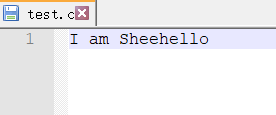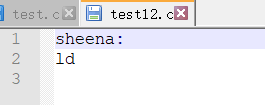C语言之文件详解
-
一般在程序设计中的文件类型有两种:程序文件、数据文件。
-
程序文件:包括源程序文件(.c)、目标文件(.obj)、可执行文件(.exe)
-
数据文件:该文件的内容不是程序,而是程序运行时读写的数据。本篇博客就是对数据文件的操作的讨论。
1.文件名
- 文件名是一个文件的唯一标识,用于识别和引用该文件。
- 文件名包含3个部分:文件路径+文件名主干+文件后缀
- 如:D:\sheena\test.txt。
2.文件类型
- 文本文件:数据在内存中以二进制形式存储,若要求在外存上以ASCII码的形式存储,则需要存储前转换。该种以ASCII字符的形式存储的文件就是文本文件。
- 二进制文件:数据在内存中以二进制形式存储,若不加转换依旧以二进制形式的输出到外存中,该文件即二进制文件。
3.文件缓冲区
- ANSIC标准采用缓冲文件系统处理的数据文件的。
- 缓冲文件系统:指系统自动地在内存种为程序种每一个正在使用的文件开辟一块“文件缓冲区”。从内存向磁盘输出数据会先送到内存中的缓冲区,装满缓冲区后才一起送到磁盘上。如果从磁盘向计算机读入数据,则从磁盘文件中读取数据输入到内存缓冲区(充满缓冲区),然后再从缓冲区逐个地将数据送到程序数据区。缓冲区的大小根据C编译系统决定的。
4.文件指针
- 每个被使用的文件在内存中开辟了一个相应的文件信息区,用来存放文件的相关信息,这些信息是保存在一个结构体变量中的。该结构体类型是由系统声明的,取名为FILE。
struct _iobuf{
char *_ptr;
int _cnt;
char *_base;
int _flag;
int _file;
int _charbuf;
int _bufsiz;
char *_tmpfname;
};
typedef struct _iobuf FILE;
- 创建一个FILE的指针变量: FILE pf;
- 可以通过文件指针变量找到与它关联的文件。
5.文件的打开关闭
- 文件在读写之前应该先打开文件,在读写之后使用该文件结束之后应该关闭文件。
(1)数据文件的打开
- fopen
- FILE * fopen ( const char * filename, const char * mode );
- 打开一个文件
- 成功返回该文件的文件指针,失败返回空指针。
(2)数据文件的关闭
- fclose
- int fclose(FILE *stream);
- 关闭一个文件
- 成功返回0,失败返回EOF(文件结束标识符,-1)
//mode:打开方式
"r"(只读,覆盖写):为了输入数据,打开一个已经存在的文本文件。如果指定文件不存在则出错。
"w"(只写):为了输出数据,打开一个文本文件。如果指定文件不存在则建立一个新的文件。
"a"(追加写):向文本文件尾添加数据。如果指定文件不存在则出错。
"rb"(只读,覆盖写):为了输入数据,打开一个二进制文件。如果指定文件不存在则出错。
"wb"(只写):为了输出数据,打开一个二进制文件。如果指定文件不存在则建立一个新的文件。
"ab"(追加写):向一个二进制文件尾添加数据。如果指定文件不存在则出错。
"r+"(读写):为了读和写,打开一个文本文件。如果指定文件不存在则出错。
"w+"(读写):为了读和写,建立一个新的文件。如果指定文件不存在则建立一个新的文件。
"a+"(读写):打开一个文件,在文件尾进行读写。如果指定文件不存在则建立一个新的文件。
"rb+"(读写):为了读和写打开一个二进制文件。如果指定文件不存在则出错。
"wb+"(读写):为了读和写,新建一个新的二进制文件。如果指定文件不存在则建立一个新的文件。
"ab+"(读写):打开一个二进制文件,在文件尾进行读和写。如果指定文件不存在则建立一个新的文件。
#include 6.文件的读写
(1)数据文件的顺序读写
①fgetc
- int fgetc ( FILE * stream );
- 字符输入函数,从文件中读取一个字符,适用于所有输入流。
- 成功返回读取的字符(提升为int型),失败返回EOF(文件结束标识符,-1)
#include - int fputc ( int character, FILE * stream );
- 字符输出函数,将字符输入到文件指针指向的指定文件中,适用于所有输出流。
- 成功返回写入的字符(提升为int型),失败返回EOF(文件结束标识符,-1)
#include - char * fgets ( char * str, int num, FILE * stream );
- 文本行输入函数,从文件中读取数据,读到换行符为止,适用于所有输入流。从文件中读到程序中。
- 成功返回读到的字符串str,失败或读到文件结尾时返回NULL。
#include - int fputs ( const char * str, FILE * stream );
- 文本行输出函数,从程序中输出到文件中,向指定文件中写入字符串,适用于所有输出流。
- 成功返回0,失败返回EOF。
#include - int fprintf ( FILE * stream, const char * format, … );
- 格式化输出函数,将数据写到文件中,适用于所有输出流。
- 成功返回输出的字符数,失败返回一个负值。
- 和printf用法差不多,只不过fprintf的使用时需要指定写入的文件指针。
#include ⑥fscanf
- int fscanf ( FILE * stream, const char * format, … );
- 格式化输入函数,对应fprintf,将文件中的数据输入到程序中显示,适用于所有输入流。
- 与fgets区别在于:fscanf遇到换行和空格时结束,而fgets遇到空格不会结束。
- 成功返回输入到程序中的字符个数,失败返回EOF。
- 与scanf一样使用,只不过加一个要读的文件的文件指针。
#include - size_t fread ( void * ptr, size_t size, size_t count, FILE * stream );
- 二进制输入,从一个文件中读数据,适用于文件。
- 成功返回读取元素总数,失败或者读到文件末尾返回0。
⑧fwrite
- size_t fwrite ( const void * ptr, size_t size, size_t count, FILE * stream );
- 二进制输出,将数据写入文件中,适用于文件。
- 成功返回写入的元素的总数,失败返回0。
#include (2)数据文件的随机读写
①fseek
- 根据文件指针的位置和偏移量来定位文件指针
- int fseek ( FILE * stream, long int offset, int origin );
- 成功返回0,失败返回非0。
//origin
不变 参考位置
SEEK_SET 文件开始
SEEK_CUR 文件指针的当前位置
SEEK_END 文件结尾*
#include - 得到文件指针相对于起始位置的偏移量
- long int ftell ( FILE * stream );
- 成功返回当前位置的偏移量,失败返回-1L。
#include - 让文件指针的位置回到文件起始的位置。
- void rewind ( FILE * stream );
- 无返回值。
#include 7.文件结束符判定
- 在文件读取过程中,不能用feof函数的返回值直接用来判断文件的是否结束。而是应用于当文件读取结束时,判断是读取失败结束,还是读到文件末尾结束。
- 文本文件:判断返回值是否为EOF(fgetc),NULL(fgets)
- 二进制文件:判断返回值是否小于实际要读的个数。
#include 8.文件操作的总结
#include 







